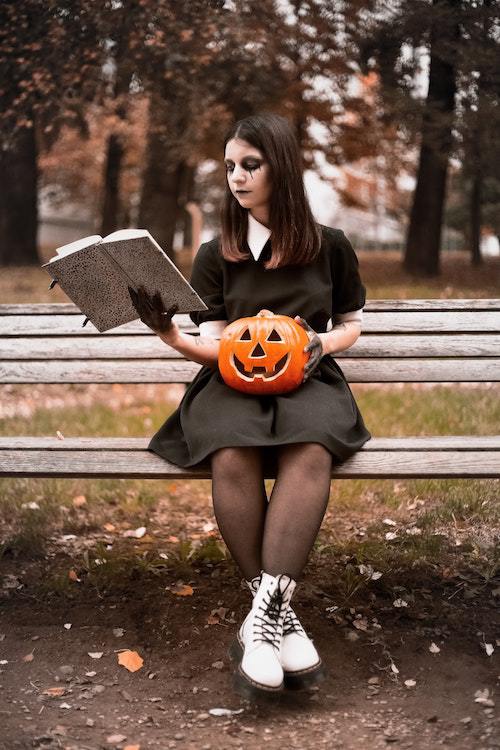Spooky season has arrived, and the autumn weather invites you to hunker down with a cup of tea, coffee, or whatever cozy beverage you prefer and delve into a modern twist on the classic gothic horror genre. These two talented Latinx authors each weave dark social issues and cultural anxieties into their writing. Here are song suggestions inspired by each novel to invite you even further into the world of terror and dread.
Mexican Gothic by Silvia Moreno Garcia
Set in Mexico in the 1950s, Noemi, a wealthy, young, beautiful socialite is called upon to help her cousin, Carolina, after receiving a distressing letter begging Noemi to save her from her new husband, who she insists is poisoning her. Noemi stays in Carolina’s aging family home where she slowly unravels a family curse: a legacy of unspeakable terror and violence.
From the novel’s protagonist, to its setting, to its central themes, Mexican Gothic successfully subverts the horror genre. Typically classic gothic horror novels have strong undercurrents of racism towards non-Europeans, with people of color being a source of fear and anxiety. Garcia alters this perspective of the Other, and it’s what the novel frames as horrifying that’s distinguishing—exploitators and colonizers as equivalent to rot and death.
While Silvia Moreno Garcia’s works span various genres, all of them infuse Mexican characters and culture into the stories. She was determined to place the novel in Mexico, despite receiving criticism that people would never read a horror novel that takes place there. Her writing creates an eerie atmosphere, using the horror genre to propel metaphors that tackle larger issues such as colonization, racism, cultural appropriation, colorism, and misogyny.
Pair with “Girls Just Wanna Have Some” by Chromatics
An ethereal and uncanny contemporary remix of Cyndi Lauper’s classic, “Girls Just Wanna Have Fun,” this song’s lyrics speak to Noemi and Carolina’s desire for modernity, independence, and freedom while living under familial and patriarchal constraints.
Pair with “Werewolf Heart” by Deadman’s Bones
Spearheaded by the internet’s boyfriend, Ryan Gosling, Deadman’s Bones entire catalog is filled with haunting themes that are described by Gosling himself as “spooky doo-wop.” “Werewolf Heart’s” essence captures the love story between Noemi and Francis that develops out of tragic circumstances, offering a hopeful silver lining to an otherwise deeply disturbing story.
Children of Chicago by Cynthia Pelayo
Cynthia Pelayo’s genre-bending novel converges gothic horror with crime fiction, using the story of The Pied Piper as a nod to the strong influence of dark fairy tales on the horror genre. Nominated for an International Latino Book Award for Best Crime Fiction, Puerto Rican author and Chicago native introduces us to the novel’s protagonist, detective Lauren Medina, when the murder of a young, innocent, woman conjures disjointed memories of her own haunted past of family tragedies—all of her immediate family members are dead and her younger sister was murdered in a similar fashion to the opening crime scene. Graffitied near the body is the tag,”Pied Piper.” This sparks an unhealthy obsession for Medina, who has a strong childhood connection to Grimms Fairy Tales and believes there must be a link with the murders of so many innocent children in Chicago.
Weaving mystifying classic fairy tales into modern storytelling, Pelayo’s writing is a stark reminder that like trauma itself, stories of the past continue to have a powerful hold on the collective consciousness today. Concerning Medina’s own trauma and plight, we are encouraged to sympathize with her, but we struggle to root for her when her occupation as a detective and a woman of color makes her full of contradictions and questionable choices. Her PTSD leads to disorienting hallucinations that make it difficult for readers to discern if we can trust her and anyone else around her, a horrifying realization in and of itself.
Beyond its grittiness is a strong sense of home, Children of Chicago is ultimately a love letter to the city. Admiration for the city’s people, architecture, authors, and musicians shines through the novel’s grisly tone. Chicago serves as both the epicenter of detective Medina’s personal struggles and the perfect landscape for gloomy urban crime fiction. It’s a city haunted by its history of violent crime, gangs, and “boogeymen” that plague marginalized communities, with women of color often being the victims of unsolved murders that never see justice.
Pair with “I’ll Be Glad When You’re Dead, You Rascal You” by Louis Armstrong
“I’ll Be Glad When You’re Dead” encapsulates the sense of paranoia and distrust that permeates throughout Children of Chicago. Detective Medina describes her childhood home as one filled with the sounds of Chicago blues artists, including revolutionary jazz musician Louis Armstrong.
Pair with “Kids See Ghosts” by Kids See Ghosts
This hip-hop duo is composed of one of Chi-town’s very own Kanye West and Kid Kudi. Their song, “Kids See Ghosts,” reflects a child’s willingness to see what adults can’t, much like Detective Medina’s introspective and painful search for truth within terrifying children’s fairy tales, giving her insight into what others around her are reluctant to see.

